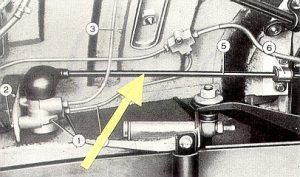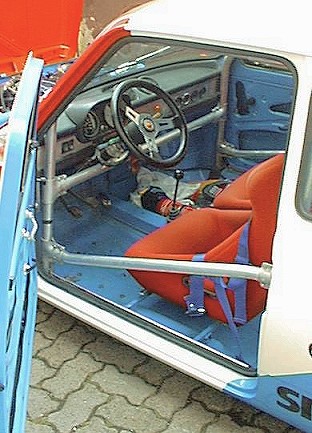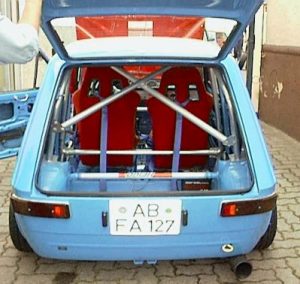By Rob Miller
 The 127 is one of Fiats best kept secrets, it’s been so secret that only the initiated really know the potential of these little gems. Tune in to www.fiat-abarth.de in the land of the frankfurter where they really are into 127″s. There’s an emerging following in the UK, but as yet the penny hasn’t dropped in a big way.
The 127 is one of Fiats best kept secrets, it’s been so secret that only the initiated really know the potential of these little gems. Tune in to www.fiat-abarth.de in the land of the frankfurter where they really are into 127″s. There’s an emerging following in the UK, but as yet the penny hasn’t dropped in a big way.
Introduced in 1971 with a wheezing pushrod 903cc engine it sold in its thousands, but it was slow; it took until 1977/8 for Fiat to give it a few more horses and the little 5 main bearing “Brazil” OHC 1050cc unit was born with a massive 50bhp! But by the end of that year, Fiat had the1050 unit breathed on by those clever Abarth boys and the 127 1050cc Sport was put on the market with a 40% increase in power to 70BHP @ 6500 RPM. This was no mean feat for a small capacity engine of only 1050cc and Fiat were so confident of their engineering on this little screamer, it was red lined at an incredible 7200rpm. And this was a production line car!!!
Taking advantage of this little engines capabilities, Fiat reduced the final drive ratio from the standard 4.07 to 1 down to 4.46 to 1. The gearbox ratios were unaltered. The Sport pulled just 14.5mph per 1000 revs in top gear. It was, and is to this day, a high revving phenomenon.
It may take some swallowing, but this little piece of equipment will handle as good as any modern hot hatch, even without any modifications. A bog standard Sport, or 1300GT in good nick will annoy many modern posers in Euro clone hatches.
Night time shot of a sleeping Series 3 127 1300GT
Most parts are interchangeable between all the 127 models, and the old 903cc unit can be easily swapped for the stronger ohc engine. The only major differences being the 5-speed gearbox from the later model, which requires bodywork modifications if one is thinking of installation into an earlier car. (This is dealt with later in this article) Other differences are trim, lighting and body; these being the larger headlights on the series three and the tailgate, bonnet, and higher rear window lines on the series one…. We are talking here only the three-door hatchback model as few, if any, of the saloon versions are still around in the UK.
The 1050 and 1301 “Brazil” engines are very strong and free revving units, developing 50bhp (standard 1050 ohc engined cars) 70bhp (Sport) and 75bhp (1300GT) in standard mode. Some Italian racers managed to extract 130+ BHP from the 1050 engine attaining some 9,000rpm plus momentarily.
The thing is, the 127 weighs in at a paltry 700kgs, so if you take out all that unwanted interior trim, (your silken thighed babe will have to sit on the floor) all that exterior plastic; it weighs next to nothing.. .it will come in lighter than the chairwoman of the local anorexics anonymous club! Now throw in the standard 70bhp Sport engine and you have a potential “cossie” chaser with a power to weight ratio better than almost all modern euro hatches.
If only Fiat had developed the 127 as VW developed the Golf, we would have had a much more refined “Punto” today.
NOTE ON UNLEADED / LEADED FUEL:
 The 1050 and 1301 engines will run on unleaded fuel in standard and a mildly tweaked state of tune. You will need to retard the ignition slightly due to the lower octane value of unleaded fuel. Alternatively, the Shell UK “Optimax” fuel can be used and in many instances may not necessitate any adjustment to the ignition timing. There is no definitive information regarding these engines, even Fiat are vague in this area; some pundits say yes, others no. But there are many people who happily run their 127’s using unleaded. If you are intending to drive your 127 “hard”, which may well be your intent in reading this article, then either the use of a recommended additive is wise; or get the cylinder head/valves/seats modified to suit.
The 1050 and 1301 engines will run on unleaded fuel in standard and a mildly tweaked state of tune. You will need to retard the ignition slightly due to the lower octane value of unleaded fuel. Alternatively, the Shell UK “Optimax” fuel can be used and in many instances may not necessitate any adjustment to the ignition timing. There is no definitive information regarding these engines, even Fiat are vague in this area; some pundits say yes, others no. But there are many people who happily run their 127’s using unleaded. If you are intending to drive your 127 “hard”, which may well be your intent in reading this article, then either the use of a recommended additive is wise; or get the cylinder head/valves/seats modified to suit.
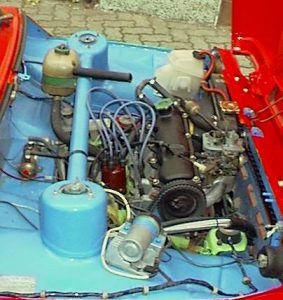 Closely related to the 127 is the Lancia Y10, this vehicle had an option of turbo power and used the “Brazil” engine, this could be another choice in the quest for improved performance and possibly a cheaper alternative if working to a budget. Problem is the Y10 Lancia Turbos were never big sellers, so are extremely rare.
Closely related to the 127 is the Lancia Y10, this vehicle had an option of turbo power and used the “Brazil” engine, this could be another choice in the quest for improved performance and possibly a cheaper alternative if working to a budget. Problem is the Y10 Lancia Turbos were never big sellers, so are extremely rare.
Though the 903cc engine can be modified and the unit is renowned to rev a little bit, for performance; the later OHC engines are the preferred unit. These engines, along with the later four-speed box can easily be fitted to the series one cars. (See comments later regarding the five-speed gearbox)
Standard 1050cc engines can be converted to the Sport specification by fitting the 1050 Sport cylinder head and carburetor, suggest you renew the timing belt at the same time. I have not gone into great detail in this article about engine modification, as this would be another complete article altogether. Needless to say, the 1050 Sport and thel300GT engines, in only mildly tuned form; i.e. Exhaust / carburettor / ignition / suspension / wheels will out perform any modern small hatch boy racer.
SUSPENSION:
Standard 127’s have coil-over struts at the front and strut type vertical shocks at the rear.

Modified coil overs with adjustable spring cups. Note drilled discs and cutaway inner wing to accommodate 5 speed gearbox
On the front there is an anti roll bar fitted, which on the Sport and 1300GT is of larger diameter to the standard cars. (a good modification when fitted to a lesser model) The rear suspension is unusual in that there is a transversely mounted leaf spring; this is not mounted at its center, but at each side by means of two clamps. The spring acts as an anti roll bar.
To lower the front suspension, shorter coils need to be fitted and these can be obtained through companies such as Demon Tweaks using X19 springs of suitable size and poundage.
The rear suspension has to be tackled by modification to that spring. It can be removed without any use of Anglo Saxon by undoing the clamps that retain it, there is no need to dismantle any more of the rear suspension components. There are three options to lower the rear of a 127:
- Remove the spring and have it decambered (flattened) by a company such as Brost or Leda Suspensions.
- Fabricate a clamp to squeeze the spring, so puffing the wheels up into the arches. Make up two pieces of metal approximately 10″ long at least 1/2″ thick by about 5″, drill two 3/8″ clearance holes each end and using at least 6″ bolts mount one piece over the spring, the other under, insert the bolts through the clearance holes and proceed to tighten the bolts. This will clamp the spring and pull the wheels up into the arches.
- Remove the inner bracket mounting bolts and replace with longer bolts. By using oversize nuts as spacers, by trial and error you will lower the rear.
 NOTE!! On 127’s there is a device in the hydraulic braking system called The Rear Brake Regulator. It works in conjunction with the rear suspension and depending on the ride height of the rear, will alter the brake bias between the front to the rear. It operates via a rod connected to the suspension arm. Basically the device stops the rear wheels locking up when braking hard, and alters the pressure to the rear brakes. So if you lower it, the device thinks there’s three fat ladies sat in the back and alters the break bias accordingly. Suggest you throw it away and fit a break bias valve adjustable from within the car. These valves are available from most tuning firms and are not make related.
NOTE!! On 127’s there is a device in the hydraulic braking system called The Rear Brake Regulator. It works in conjunction with the rear suspension and depending on the ride height of the rear, will alter the brake bias between the front to the rear. It operates via a rod connected to the suspension arm. Basically the device stops the rear wheels locking up when braking hard, and alters the pressure to the rear brakes. So if you lower it, the device thinks there’s three fat ladies sat in the back and alters the break bias accordingly. Suggest you throw it away and fit a break bias valve adjustable from within the car. These valves are available from most tuning firms and are not make related.
Shock absorbers are not available “off the shelf” modified, but there are many firms such as Leda who will modify your shocks to any specification. Including up to adjustable spring cups and coil over Though on the rear of the 127 room is tight for coil-overs due to the close proximity to the wheel, one would need to modify the mountings if coil-overs were imperative. Turreting is the alternative and this is done by fitting strut type top chassis mountings to the rear wheel tubs. Using a strut brace between the two can further stiffen the set up.
NEGATIVE CAMBER: Track control arms and strut top mountings can be modified by companies such as Leda suspensions or any of the companies who usually advertise in, dare I mention it, “Classic Ford”. The Fiat design of the rear suspension allows the adjustment of camber by means of removal or insertion of spacers in the rear Pivot mountings. Adjustment is made by fitting more adjustment spacers into both the mounting points. The bottom of the wheel is pushed outwards, so giving negative camber.
Polyurethane bushes will stiffen up the front suspension but unfortunately; the various manufacturers do not list them. They do, however, make some fitments for the Fiat 128. This has an almost identical set up to the 127 and they will fit. Some companies will supply “blank” material from which requirements can be made up.
BODYWORK:
The 127-monocoque construction was ok when it left the factory in Turin Italy, but by today’s standards it was not an extremely rigid shell. This, coupled with poor quality sheet steel and corrosion, will mean that some work will be needed to enable the 127 tuner to finish up with a quick, high performance, sweet handling little hatchback.
Assuming that the shell is now free of the inevitable tin worm, a good quality full roll cage will stiffen up the passenger cell. Strut braces both front and rear, and if circuit racing or track days are contemplated, front to rear bracing between front and rear strut tops.

 All of which could be incorporated into the roll cage Lowering, modification to braking, suspension and in particular the fitting of wider, larger diameter wheels; will necessitate the wheel arches being cut to accommodate any thing bigger than say 6×13 with 175x50x13 profile tyres. A stripped out 127 with no glass is a quite light car, but removing the roof and replacing with thin sheet alloy or even fibreglass can obtain further lightening of the body. Many racers remove the door skins and replace with alloy or fibreglass. Some go even further in weight reduction, and using a hole cutter in positions where body strength will not be weakened, remove even more metal. Power to weight ratios are an important factor in reducing lap times and by lowering the centre of gravity the handling can be further enhanced.
All of which could be incorporated into the roll cage Lowering, modification to braking, suspension and in particular the fitting of wider, larger diameter wheels; will necessitate the wheel arches being cut to accommodate any thing bigger than say 6×13 with 175x50x13 profile tyres. A stripped out 127 with no glass is a quite light car, but removing the roof and replacing with thin sheet alloy or even fibreglass can obtain further lightening of the body. Many racers remove the door skins and replace with alloy or fibreglass. Some go even further in weight reduction, and using a hole cutter in positions where body strength will not be weakened, remove even more metal. Power to weight ratios are an important factor in reducing lap times and by lowering the centre of gravity the handling can be further enhanced.
GEARBOX:
Not a lot of room for manoeuvre here as only three types of gearbox were ever fitted to the 1050 and 1301 “Brazil” engines.
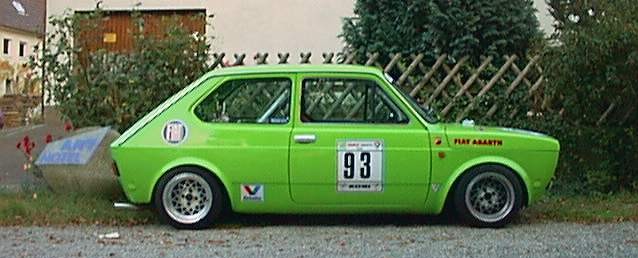 The standard 1050 had a four-speed box with a final drive ratio of 4.07 to 1. The five-speed box had the same final drive ratio with the fifth gear at 0.830 to 1, and the Sport had a four-speed box with identical ratios to the standard, but with a lower final drive ratio of 4.46 to 1. Owners of series one and two cars (1971 to 1981) with the four-speed gearbox cannot fit the longer legged five-speed unit without first modifying, or fitting the later (series three 1981 on) nearside inner wing. Fiat had to redesign the nearside in order to fit the longer 5-speed box; the metal is cut away in order to allow the box to sit under the inner wing (the gearbox is about 4 inches longer). The nearside mounting is also different on the 5-speed box.
The standard 1050 had a four-speed box with a final drive ratio of 4.07 to 1. The five-speed box had the same final drive ratio with the fifth gear at 0.830 to 1, and the Sport had a four-speed box with identical ratios to the standard, but with a lower final drive ratio of 4.46 to 1. Owners of series one and two cars (1971 to 1981) with the four-speed gearbox cannot fit the longer legged five-speed unit without first modifying, or fitting the later (series three 1981 on) nearside inner wing. Fiat had to redesign the nearside in order to fit the longer 5-speed box; the metal is cut away in order to allow the box to sit under the inner wing (the gearbox is about 4 inches longer). The nearside mounting is also different on the 5-speed box.
WHAT YOU NEED TO FIT THE 5 SPEED GEARBOX:
 The nearside inner wing is very different to vehicles fitted with the 4-speed box, so this is probably the most difficult area to modify. You will need to be skilled in cutting and welding, or to be able to fit the series three inner wing. What Fiat did to accommodate the 5th gear was to dramatically cut away the inner wing to allow the fitment of the somewhat longer 5-speed gearbox. After this work is done you will need the five speed gear change linkage, the nearside mounting, and the larger type tripod ended drive shafts as fitted to 127’s post 1981. If you wish to incorporate the larger Constant Velocity joints then the hubs from a five-speed vehicle will also be required.
The nearside inner wing is very different to vehicles fitted with the 4-speed box, so this is probably the most difficult area to modify. You will need to be skilled in cutting and welding, or to be able to fit the series three inner wing. What Fiat did to accommodate the 5th gear was to dramatically cut away the inner wing to allow the fitment of the somewhat longer 5-speed gearbox. After this work is done you will need the five speed gear change linkage, the nearside mounting, and the larger type tripod ended drive shafts as fitted to 127’s post 1981. If you wish to incorporate the larger Constant Velocity joints then the hubs from a five-speed vehicle will also be required.
There are close ratio competition gearboxes available only from Italy, but these are by no means cheap and could cost in excess of £1000.
I am not aware of any competitive 127 actively involved in hill climbing, but the Sport low final drive box would, I believe be perfect.
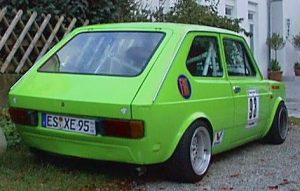 It is worthwhile noting that 127 drive shafts can vary in length; this may be due to poor quality control or because of different manufacturers. But if the front suspension has been modified to incorporate negative camber, there have been cases of the shaft disconnecting with dire results. So it’s beneficial not to be too dramatic when adjusting front camber settings! The ideal set up is about 1.5 degrees front and rear.
It is worthwhile noting that 127 drive shafts can vary in length; this may be due to poor quality control or because of different manufacturers. But if the front suspension has been modified to incorporate negative camber, there have been cases of the shaft disconnecting with dire results. So it’s beneficial not to be too dramatic when adjusting front camber settings! The ideal set up is about 1.5 degrees front and rear.
All the “Brazil” OHC engines will fit the three gearboxes mentioned above.
DRIVE SHAFTS: again we are talking “Brazil” engined cars. In 1981 the drive shafts/CV’s were modified in diameter so both 1050cc and 1301cc cars had larger diameters than those fitted to earlier “Brazil” engined cars, so they are stronger.
WHEELS AND TYRES:
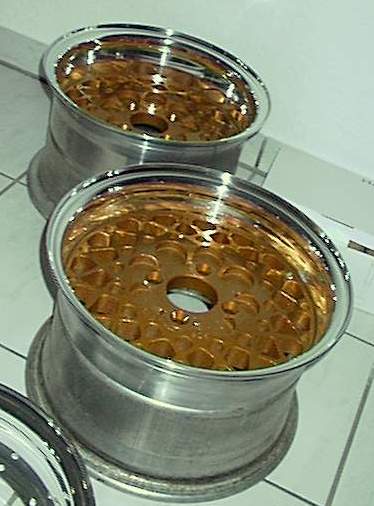 Unfortunately the 127 arches don’t lend themselves to having really wide or large diameter wheels/tyres. So fitting 6″x 13″ wheels with say 175 50 13 rubber is about the maximum one can go after lowering the car 2″. Any thing greater than this will require modification to nearby metal work. The Germans like to fit 7″x 13″ wheels with 205 low profiles; but all of their 127’s have had the wheel arches relieved. Some have even fitted 8″.
Unfortunately the 127 arches don’t lend themselves to having really wide or large diameter wheels/tyres. So fitting 6″x 13″ wheels with say 175 50 13 rubber is about the maximum one can go after lowering the car 2″. Any thing greater than this will require modification to nearby metal work. The Germans like to fit 7″x 13″ wheels with 205 low profiles; but all of their 127’s have had the wheel arches relieved. Some have even fitted 8″.
When choosing those round bits it’s very wise to check the offsets and the type of fixing that are supplied with them. The PCD on these Fiats is rather close compared to other manufacturers, which means that the bolt or stud holes may be a tad small in diameter. This means that in some cases the socket head will not enter the stud hole. You may well have to obtain special bolts.
The only alloy wheel ever fitted standard to the 127 was on the Palio series two car. These were a slot type pattern of 4 %” J fitting. All other wheels on 127’s were steel.
Alfa Romeo, Lancia and other Standard Fiat alloys will fit, but always fit or check before parting with folding stuff.
BRAKES:
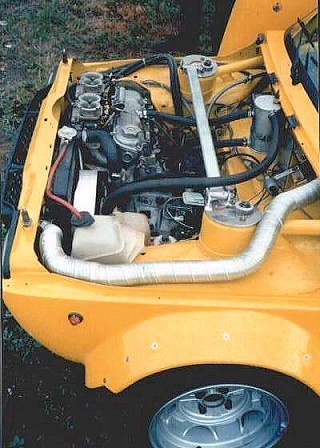 The Sport and 1300GT were fitted with remote brake servo’s and some later 1300 CL’s came with this option. So if one is upgrading the brakes on a lesser model, this is a good improvement. I mentioned before the rear brake regulator, and this is best discarded in favour of an interior fitted brake bias valve, which should be installed so that adjustment can be made to hand.
The Sport and 1300GT were fitted with remote brake servo’s and some later 1300 CL’s came with this option. So if one is upgrading the brakes on a lesser model, this is a good improvement. I mentioned before the rear brake regulator, and this is best discarded in favour of an interior fitted brake bias valve, which should be installed so that adjustment can be made to hand.
Brake discs can be upgraded to the Tarox Type, and you can experiment with different friction material. The 127-brake system is good and can cope with any increases in power.
Some tuners have modified Uno Turbo front and rears. The X19 brakes have also been mutated to fit. It depends on the usage and personal tastes.
The pads on 127 brakes have been known to wear “wedge” shaped, this is down to sticky sliders. Rear brake adjustment is awkward and can be an absolute bugger to adjust up. I have to admit that I recently had to get the rears up and stopping by adjusting the hand brake cable.
ODDS AND SODS:
LIGHTING, if you are upgrading the headlights to halogen bulbs and the car your upgrading didn’t originally have them, you will need to wire in a relay. If you don’t, the switch on the dashboard/steering column will possibly burn, or catch fire.
INSTRUMENTS: On series two cars, the instruments from the Sport can be fitted to lesser model dashboards. Fiat, in their spaghetti wiring wisdom put the same wiring loom in all series two cars produced after the Sport was introduced. You will find the necessary connections behind the dash ready to upgrade to Sport specification. If you have a series two built before the Sport then you have some extra wiring to sort! The oil pressure gauge will need the Sender unit, Oil Pipe, and oil pipe connection bolt (found on the bottom offside of the engine block) Its different to the standard one because it allows the oil feed pipe to be connected. If you cannot get hold of one, any hydraulic hose company should be able to make up a fitment using the sender unit and standard bolt as pattern for thread.
TIMING BELT:
The 1301cc-timing belt is very slightly longer than the 1050cc-timing belt. Its probably one tooth, but enough to “cock up” so don’t get them mixed up.
IGNITION:
If you are contemplating the regular use of 5000 plus rpm, I would strongly recommend changing the ignition system to electronic. That mechanical Magnetti Marelli distributor will inevitably go into “points bounce” and you will lose power.
Lumenition, (probably the best) do a kit for the 127 (part no. PMA5OIFK5O5).
These are available through many distributors and I got mine from Demon Tweaks. There is a race version available which utilises a “fixed” dwell angle.
ENGINE / GEARBOX RUBBER MOUNTINGS: these are getting harder and harder to purchase new, so don’t throw your old ones away if they’re still serviceable
SERIES 1.2.3.: As the body style was basically the same throughout the production run, most body and interior items can be swapped and changed.
USEFUL CONTACTS:
Leda Suspension 01376 326531
Rally Design (brake bias valves) 01795 531871
Automec (brake pipes) 01280 822818
Tube Torque (specialist exhausts) 01625 511153
Spax 0906 3027729
Ricambio 020 8642 8577
www.fiat-abarth.de Fantastic web site particularly for the 127. Its German so you will need to translate (suggest www.babelfish) Everything you may need to swap buy and find out the Forum is very good.
www.fiat127.com Site run by fmc 127 registrar
Fancy Engineering 01300 345577
Alternative autos 01484 865086
Auto Italia Magazine
Quaife engineering (specialist gearboxes) 01732 741144
Southern carbs (Webers) 020 8540 2723
Prefab motor sport eng. (specialist fabricator) 01777228004
Demon Tweaks. Outlets throughout the UK
If your stuck and can’t find what you need for your 127, pester the UK Italian suppliers for names in Italy. Pursue the Italian related magazines for possible contacts. Chase the known Italian tuning parts suppliers for the 127 parts. If we all make enough NOISE about this car they will take notice and make available.
 THANK YOU:
THANK YOU:
The pictures featured in this article were reproduced with the permission of Marcus Maurer of www.fiat-abarth.de

![Fiat Motor Club [GB]](https://fiatmotorclubgb1.netfirms.com/wp-content/uploads/2017/11/Website-Header-v3.jpg)


